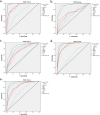NMD-12: A new machine-learning derived screening instrument to detect mild cognitive impairment and dementia
- PMID: 30849106
- PMCID: PMC6407752
- DOI: 10.1371/journal.pone.0213430
NMD-12: A new machine-learning derived screening instrument to detect mild cognitive impairment and dementia
Abstract
Introduction: Using machine learning techniques, we developed a brief questionnaire to aid neurologists and neuropsychologists in the screening of mild cognitive impairment (MCI) and dementia.
Methods: With the reduction of the survey size as a goal of this research, feature selection based on information gain was performed to rank the contribution of the 45 items corresponding to patient responses to the specified questions. The most important items were used to build the optimal screening model based on the accuracy, practicality, and interpretability. The diagnostic accuracy for discriminating normal cognition (NC), MCI, very mild dementia (VMD) and dementia was validated in the test group.
Results: The screening model (NMD-12) was constructed with the 12 items that were ranked the highest in feature selection. The receiver-operator characteristic (ROC) analysis showed that the area under the curve (AUC) in the test group was 0.94 for discriminating NC vs. MCI, 0.88 for MCI vs. VMD, 0.97 for MCI vs. dementia, and 0.96 for VMD vs. dementia, respectively.
Discussion: The NMD-12 model has been developed and validated in this study. It provides healthcare professionals with a simple and practical screening tool which accurately differentiates NC, MCI, VMD, and dementia.
Conflict of interest statement
The authors have declared that no competing interests exist.
Figures
References
MeSH terms
LinkOut - more resources
Full Text Sources
Medical


